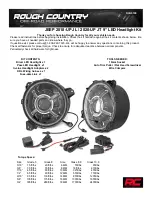
Driving on wet roads
Aquaplaning
If water has accumulated to a certain depth on
the road surface, there is a danger of aquaplan-
ing occurring, even if:
R
you are driving at low speeds
R
the tyres have adequate tread depth
For this reason, drive in the following manner in
the event of heavy rain or in conditions in which
aquaplaning can occur:
R
lower your speed
R
avoid tyre ruts
R
avoid sudden steering movements
R
brake carefully
Driving on flooded roads
!
Bear in mind that vehicles travelling in front
or in the opposite direction create waves. This
may cause the maximum permissible water
depth to be exceeded.
These notes must be observed under all cir-
cumstances. You could otherwise damage
the engine, the electronics or the transmis-
sion.
If you must drive on stretches of road on which
water has collected, please bear in mind that:
R
in the case of standing water, the water level
must be no higher than the lower edge of the
vehicle body
R
you should drive no faster than walking pace
Winter driving
G
WARNING
If you increase the recuperation level on slip-
pery road surfaces, the drive wheels may lose
their traction. This increases the risk of skid-
ding and having an accident.
Do not increase the recuperation level on slip-
pery road surfaces.
Have your vehicle winterproofed at a qualified
specialist workshop at the onset of winter.
You should drive particularly carefully on slip-
pery road surfaces. Avoid sudden acceleration,
steering and braking manoeuvres. Do not use
cruise control.
If the vehicle threatens to skid or cannot be
stopped when moving at low speed:
X
Shift the DIRECT SELECT lever to position N.
X
Try to bring the vehicle under control by using
corrective steering.
The outside temperature indicator is not
designed to serve as an ice-warning device and
is therefore unsuitable for that purpose.
Changes in the outside temperature are dis-
played after a short delay.
Indicated temperatures just above the freezing
point do not guarantee that the road surface is
free of ice. The road may still be icy, especially in
wooded areas or on bridges.
You should pay special attention to road condi-
tions when temperatures are around freezing
point.
Further information on driving with snow chains
(
Y
page 269).
Further information on driving with summer
tyres (
Y
page 268).
Observe the notes in the "Winter operation" sec-
tion (
Y
page 268).
Driving systems
Cruise control
General notes
Cruise control maintains a constant road speed
for you. It brakes automatically in order to avoid
exceeding the set speed. Change into transmis-
sion position D
-
(
Y
page 132) on long and steep
downhill gradients. This increases recuperation
in overrun mode. This relieves the load on the
brake system and prevents the brakes from
overheating and wearing too quickly.
Use cruise control only if road and traffic con-
ditions are appropriate for maintaining a steady
speed for a prolonged period. You can store any
road speed above 30 km/h.
The speed indicated in the speedometer may
differ slightly from the speed stored.
150
Driving systems
Dr
ivi
ng
an
d
parki
ng
Summary of Contents for B 250 e 2015
Page 2: ......
Page 3: ......
Page 289: ...286 ...
Page 290: ...287 ...
Page 291: ...288 ...
Page 292: ......
Page 293: ......
















































